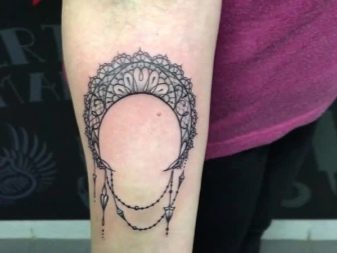All about the tattoo "Lunnitsa"

Tattoos on themes of pagan, mythological symbols are very popular. It is logical that Slavic mythology confidently keeps on this list: the symbols are beautiful, and their semantic load is interesting to study, metaphorical, filled with their own meaning. One example of this is the "Lunnitsa" tattoo, a female amulet with an unusual history.


Description and meaning
Even ancient people, not having such powerful scientific tools as astrophysicists have today, for example, understood the power of the moon as a celestial body. And they realized that it affects a person: his physiological and emotional state. Even then, it was understood that the female cycle is also associated with the moon. Hence the requests from the luminary for help, and attempts to make the moon a talisman.

The young month was considered a symbol of fertility, and therefore swimming under the young moon was considered a good thing, promising a long-awaited replenishment in the family. Therefore, the image of the moon could be applied to clothing, as well as to linen: it was believed that this would help women's health. Young girls could be given a special talisman (often a pendant), which was called a lunar. He meant the strength of the young month, patronizing women. As a talisman, he also protected from the evil eye, but was mainly responsible for women's happiness.
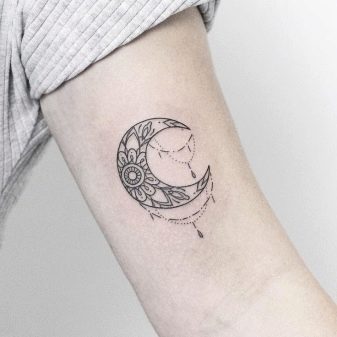
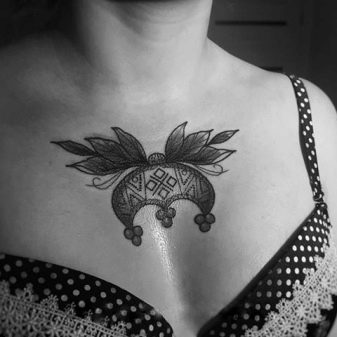
Around the 15th century, the moonfish became a popular piece of jewelry, but such earrings could only be afforded by the wealthy. But a simple pendant, made literally from scrap materials, could be made for herself by everyone.
The women believed that the moon:
-
does not give in to someone else's influence;
-
enhances feminine charm;
-
helps in conception;
-
helps in childbirth, and even stimulates lactation;
-
strengthens the spiritual connection with the beloved;
-
attracts wealth to the house.
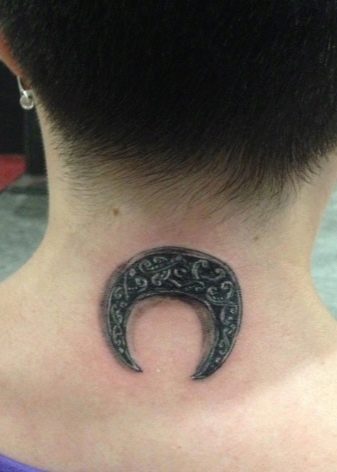
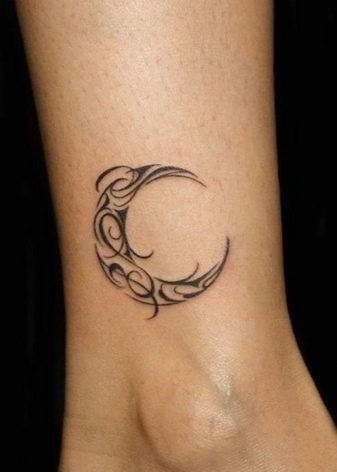
Only women could wear such a talisman.And if suddenly a man put it on, he, as people used to believe, lost some of his masculine strength. Lunnitsa, which today is increasingly found in the form of a tattoo, is also a feminine theme.
A few more interesting facts about the amulet:
-
the goddess Mara, who is responsible for fertility, was considered its patroness;
-
the amulet enhances tenderness and softness in a woman's character;
-
considered a symbol of a strong marriage;
-
ideally, it should have been presented on a birthday by a loving person (but if this did not happen, later the girl could make it herself);
-
the symbol was still important as associated with the growing up of a girl - he seemed to be her guide to the female world;
-
the shape of the amulet always remained crescent, but in general, its appearance could change - either an ornament appeared, then precious stones in the decoration (for rich people);
-
they wore a lunar with their horns down, 3 triangles were depicted on the amulet - one in the center of the decoration, and each meant the cyclical nature of life (the analogy with the cycles of the moon is clearly visible);
-
some symbols simply adorned the lunar, but there were also deeply symbolic, for example, dots - there should have been about 30 of them, each - strictly in its place, they meant the number of days in a month;
-
oblique lines on the lunar - the connection between the earthly and the heavenly, and also rain, which was considered a symbol of a fruitful year (and female fertility, if we continue the analogy);
-
the crosses on the lunar meant Christianity, a woman who wore a lunar with a cross, as it were, acquired heavenly protection;
-
amulets were with wide horns and with narrow ones, patterns more often appeared on wide-horned moonworms;
-
a spiral on the amulet is a symbol of wisdom that protects from negative energy;
-
Velesovik (a circle with several petals) is a large protective symbol.
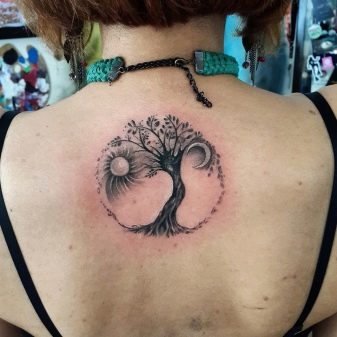

There are quite a few types of lunars alone: northerners, closed, lunar Makosh and others. This Slavic symbol has been well studied by ethnographers, so it is not a problem to find even more detailed information about it, to delve deeper into the topic. But even at the stage of superficial knowledge of the symbol, those who are close to it often think not only to wear such a decoration, but to make it a part of themselves. That is, to get a tattoo with a moon moon. It is believed that the protective effect of this symbol is manifested in this form.
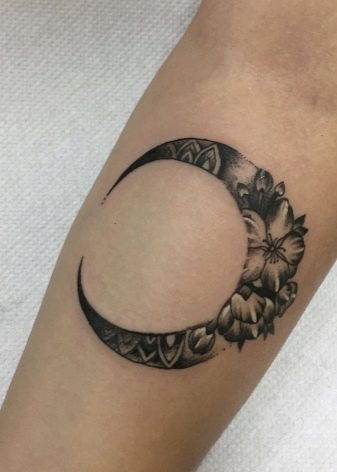

There is even a recommendation saying that the correct tactic is to independently draw up a sketch of a lunar. Then she will be truly protective. But we cannot say that everyone strictly followed this prescription: sketches are found on the Internet, in special magazines, people just see on someone and repeat.
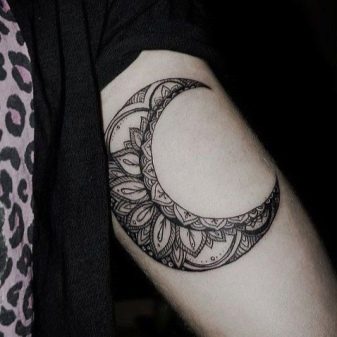
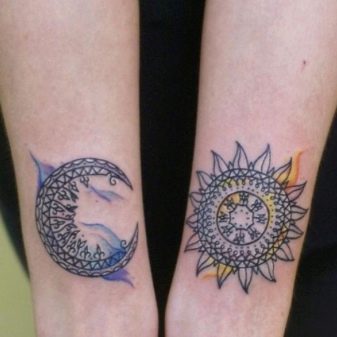
Views
In the tattoo, the most popular were 2 types of lunar. The first classic is a two-horned month with its horns facing down. The three-horned moon is a month with another, middle horn. Three horns mean cyclicality: past, present and future. These tattoos are believed to have a strong protective power.
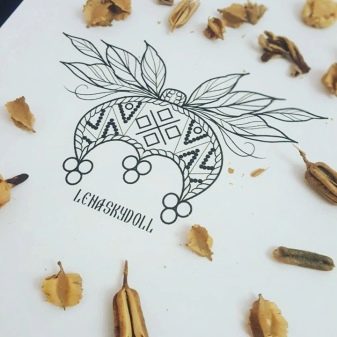
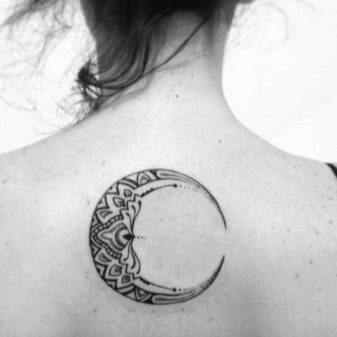
There can be many options for sketches.
-
Lunnitsa with a bracelet. Such a tattoo is often done on the arm, in the wrist area. It imitates a bracelet with an ancient female symbol. The lunar itself in this version is often three-horned. It is quite wide, has patterns and ornaments.
-
Large color with thematic images. Such a sketch is often applied to the back. Inside the lunar (its contour), a whole plot from Slavic mythology can be played out. There is a lot of color in this sketch.
-
Lunnitsa with precious stones. It is also more likely to be stuffed on the back. It is a realistic version of a natural protective jewelry inlaid with precious stones and pearls.
-
Lunnitsa with flowers. This is no longer an imitation of jewelry made of silver or other metal, but a pure drawing, the projection of which is itself a symbol. Flowers can be stylized. Such a tattoo combines a Slavic amulet and flowers as a feminine principle, a symbol of beauty, flowering.
-
Lunnitsa with horns down under a crown of branches. The tattoo looks beautiful, graceful. More often it is stuffed between the shoulder blades, and there it looks harmonious.The female symbol gains protection in the form of a plant crown, as if enveloping it.
-
A pair tattoo - a moon on one hand, a sun on the other. The two luminaries are closely related to human life, they are both antipodes to each other, and tireless replacements. Therefore, such duality is the vehicle of life, two principles, without which a person is unthinkable. It is not necessary to make a pair on hand, but this option prevails.
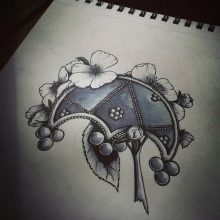

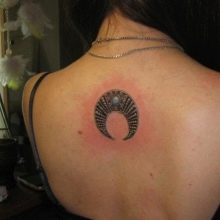
We can say that tattoos are equally popular, where the moon is a drawing of decoration, and where it is a separate graphic symbol.
Where to sketch?
The tattoo has additional meaning through the place where it is applied.
Variants of location on a woman's body.
-
Shoulder. It is believed that a tattoo in this place, especially with such a strongly pronounced gender symbol, helps to develop business skills and gain self-confidence. Especially if the female energy "sinks" in this area.
-
Wrist. Any tattoo is very strongly influenced here, because it is the heartbeat point. They say that the application of a lunar on this place prevents the appearance of a rival, helps to strengthen family relationships.
-
Next to the brush. Such a tattoo protects from betrayal, the intent of envious people. It does not allow making wrong gestures (for example, reaching out to people who can deceive, abuse of trust).
-
On the hip. Any tattoo here is designed to enhance sexuality and sensuality, to remove the "stop" from the demonstration of these qualities. Perhaps this will help the girl gain self-confidence, which means she will become more interesting as an object of attention. At the same time, the tattoo can be modest, small.
-
On the forearm. Lunnitsa in this place helps to develop intuition. The girls who fill tattoos here want to become even more discerning, to better understand people and themselves.
-
On the back. When making a tattoo in this area, many people seem to put themselves as an intercessor (“someone behind my back is helping me”). This is not always done consciously, the person himself can simply follow his feelings. Lunnitsa on the back is a talisman behind the back. It is like a buffer, like a protective layer between a vulnerable human body, his soul and the outside world.
-
On the foot. Psychologists assure that people make tattoos in this place, especially those with protective meaning, in order to start a new life or change their life path. Figuratively speaking, start taking the right steps.
-
On the finger. A rare place for a lunar, but it is found.
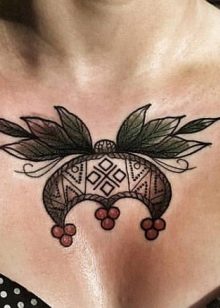
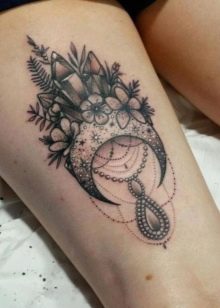
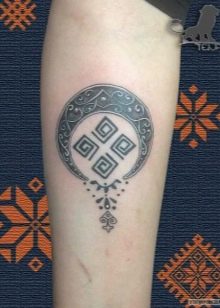
This is done by women who want to see a symbol that is important to them as often as possible. But to broadcast it to the world too, they make it a part of themselves.
Tattoos are rarely decided in one day. This means that the path associated with the appearance of the image on the body can be built with even greater care: for example, follow the tradition and think over the sketch yourself. And the master will help you correct it and make it professional.

